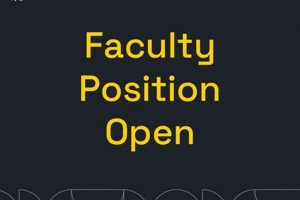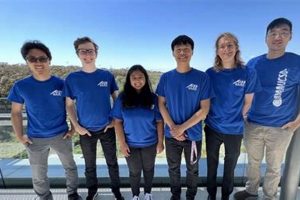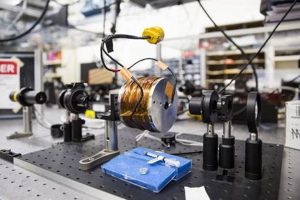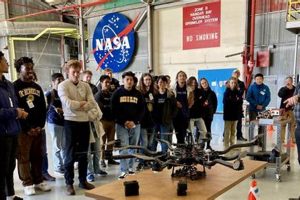The employment landscape for professionals trained in the design, development, and testing of aircraft, spacecraft, and related systems is broad and diverse. This field encompasses a range of industries and governmental organizations where specialized knowledge of aerodynamics, propulsion, materials science, and structural analysis is highly valued.
The significance of this career path lies in its contribution to advancements in air travel, space exploration, and national defense. Historically, these professionals have been instrumental in shaping technological progress, from the first successful airplane flights to the current era of satellite communication and potential interplanetary travel. The innovations they produce contribute significantly to economic growth and scientific understanding.
Opportunities exist in the commercial aviation sector, government agencies focused on space exploration, defense contractors, research and development facilities, and increasingly, in emerging areas such as drone technology and urban air mobility. The following sections will delve into specific examples and roles available within these areas.
Effective career planning is paramount for aerospace engineers seeking optimal professional placement. Diligence in acquiring specific skills and strategic networking are critical for maximizing career opportunities.
Tip 1: Focus on Specialization: Develop expertise in a niche area, such as propulsion systems, aerodynamics, or avionics. Specialized skills are highly sought after by employers in both the public and private sectors.
Tip 2: Pursue Advanced Education: A master’s degree or doctorate can significantly enhance career prospects. Advanced studies often lead to research-oriented positions and management roles within aerospace companies.
Tip 3: Gain Practical Experience: Seek internships or co-op opportunities during academic studies. Practical experience provides valuable hands-on skills and exposure to real-world engineering challenges.
Tip 4: Develop Strong Communication Skills: Effectively conveying technical information is crucial. Participate in projects that require written and oral presentations to refine communication abilities.
Tip 5: Network Actively: Attend industry conferences, join professional organizations (e.g., AIAA), and connect with engineers on professional networking platforms. Networking expands professional contacts and provides insights into job market trends.
Tip 6: Obtain Relevant Certifications: Certain certifications, such as those related to specific software or design methodologies, can enhance credibility and demonstrate proficiency to potential employers.
Tip 7: Research Potential Employers: Prior to applying for positions, thoroughly research the organization’s projects, culture, and values. This allows for targeted applications that highlight relevant skills and experience.
In summary, strategic career planning, focused skill development, and proactive networking are essential components for aerospace engineers aiming to secure desirable positions within the industry. Continuous learning and adaptation to evolving technological advancements will ensure long-term career success.
The subsequent sections will explore specific sectors and employers that actively recruit aerospace engineering talent.
1. Aviation Companies
Aviation companies constitute a primary employment sector for aerospace engineers. These organizations, encompassing manufacturers of commercial and private aircraft, are pivotal in designing, developing, and maintaining flight vehicles. The operational requirements of these companies directly necessitate the application of aerospace engineering principles across various disciplines, including aerodynamics, structural analysis, propulsion, and control systems. This interplay establishes a cause-and-effect relationship: the demand for increasingly efficient, safe, and technologically advanced aircraft directly drives the need for skilled aerospace engineers within these companies. Failure to employ qualified engineers risks compromising aircraft performance, safety, and economic viability.
Examples of aviation companies that routinely employ aerospace engineers include Boeing, Airbus, Embraer, and Bombardier. Within these entities, aerospace engineers may engage in diverse tasks, such as designing wing structures to optimize lift and minimize drag, developing advanced engine technologies to improve fuel efficiency, or integrating sophisticated avionics systems to enhance navigation and flight control. The specific roles available are contingent on the company’s focus (e.g., commercial airliners, business jets, or specialized aircraft), but the underlying demand for aerospace engineering expertise remains constant. Moreover, these companies often conduct extensive research and development, providing opportunities for engineers to contribute to cutting-edge innovations in aviation technology. The practical significance of this connection is evident in the continuous advancements in air travel, driven by the combined efforts of aerospace engineers and aviation companies.
In summary, aviation companies serve as a critical component of the overall employment landscape for aerospace engineers. Their reliance on engineering expertise for aircraft design, development, and maintenance ensures a consistent demand for skilled professionals. Understanding this relationship is vital for aerospace engineers seeking to navigate their career paths and contribute to the ongoing evolution of the aviation industry. Challenges within this sector, such as increasing fuel costs and environmental concerns, further amplify the need for innovative engineering solutions, solidifying the enduring importance of this connection.
2. Space Agencies
Space agencies constitute a significant sector for aerospace engineering employment. These governmental organizations are dedicated to the exploration of space, the development of satellite technologies, and the advancement of scientific knowledge through space-based research. The core functions of space agencies inherently rely on the expertise of aerospace engineers, establishing a direct relationship between the agencies’ objectives and the employment opportunities they provide. Without qualified engineers, the design, construction, and operation of spacecraft, launch vehicles, and ground support systems would be impossible. This fundamental dependence underscores the importance of space agencies as a major component of potential career paths for aerospace engineers.
Organizations such as NASA in the United States, the European Space Agency (ESA), the Japan Aerospace Exploration Agency (JAXA), and the Canadian Space Agency (CSA) offer various roles for aerospace engineers. Within these agencies, engineers contribute to projects ranging from designing propulsion systems for lunar missions to developing advanced materials for heat shields. For example, aerospace engineers at NASA are currently involved in the Artemis program, which aims to return humans to the Moon. This initiative necessitates engineers with expertise in areas such as rocket propulsion, spacecraft design, and mission planning. Similarly, ESA employs aerospace engineers in its Copernicus program, which focuses on Earth observation and environmental monitoring through satellite technology. The practical significance of this connection is evident in the tangible outcomes of space agency endeavors, including improved weather forecasting, enhanced communication systems, and a deeper understanding of the universe. These contributions have profound impacts on daily life and scientific progress.
In summary, space agencies represent a vital employment avenue for aerospace engineers due to their central role in space exploration and technology development. The agencies’ dependence on engineering expertise ensures a consistent demand for qualified professionals. Understanding this connection is essential for aerospace engineers seeking to align their career aspirations with the broader goals of space exploration and scientific discovery. The challenges faced by space agencies, such as reducing the cost of space travel and developing sustainable space exploration technologies, further highlight the critical role of innovative engineering solutions, reinforcing the long-term importance of this professional pathway.
3. Defense Contractors
Defense contractors constitute a substantial segment of the employment landscape for aerospace engineers. These companies, which develop and manufacture military aircraft, missile systems, unmanned aerial vehicles (UAVs), and related technologies, fundamentally rely on the specialized skills and knowledge of aerospace engineers. The dependence is causal: the demand for advanced military capabilities directly drives the need for engineers proficient in aerodynamics, propulsion, materials science, and control systems. This relationship is not merely correlational; without qualified engineers, defense contractors would be unable to fulfill their contractual obligations or maintain a competitive edge in the defense industry. The importance of this sector is further emphasized by its contributions to national security and technological advancement.
Examples of prominent defense contractors that employ aerospace engineers include Lockheed Martin, Boeing Defense, Space & Security, Northrop Grumman, and Raytheon Technologies. Within these organizations, engineers may engage in activities such as designing stealth aircraft, developing hypersonic missile systems, or improving the performance of existing military platforms. For instance, aerospace engineers at Lockheed Martin contribute to the development and production of the F-35 Lightning II, a fifth-generation fighter aircraft. Similarly, engineers at Northrop Grumman are involved in the design and manufacturing of unmanned aerial systems for surveillance and reconnaissance. The practical significance of this employment is evident in the enhanced capabilities of modern military forces and the ongoing innovation in defense technologies. The economic impact of this sector is also considerable, contributing to job creation and technological exports.
In summary, defense contractors represent a crucial employment sector for aerospace engineers due to their reliance on engineering expertise to develop and manufacture advanced military systems. Understanding this connection is essential for engineers seeking career opportunities in this specialized field. The challenges facing defense contractors, such as managing complex projects, adhering to strict security protocols, and adapting to evolving technological threats, underscore the importance of highly skilled and adaptable aerospace engineers. This sector remains a significant contributor to both national security and technological progress, thereby solidifying its enduring importance as a career path.
4. Research Institutions
Research institutions represent a vital component of the professional landscape for aerospace engineers. These entities, which include universities, government laboratories, and private research centers, are dedicated to advancing the fundamental knowledge and applied technologies that underpin the aerospace industry. Their contributions are crucial for innovation and progress in the field.
- Fundamental Research and Development
Research institutions conduct foundational research in areas such as aerodynamics, propulsion, materials science, and astrodynamics. This research forms the basis for new technologies and advancements in aircraft and spacecraft design. For example, universities may investigate novel wing designs to improve fuel efficiency, while government laboratories may focus on developing advanced materials for hypersonic vehicles. The insights gained from these efforts directly impact the capabilities of aerospace companies and government agencies, providing them with the knowledge needed to develop more efficient and effective systems.
- Advanced Technology Development
Research institutions are involved in the development of advanced technologies, such as autonomous systems, advanced sensors, and space-based manufacturing techniques. These technologies have the potential to revolutionize the aerospace industry. For instance, research centers may develop algorithms for autonomous flight control or design 3D printing systems for on-orbit manufacturing. These innovations can lead to new products, services, and business models within the aerospace sector, creating opportunities for engineers with expertise in these emerging fields.
- Collaboration and Knowledge Transfer
Research institutions foster collaboration between academia, industry, and government, facilitating the transfer of knowledge and technology. They often partner with aerospace companies on research projects, providing access to specialized expertise and facilities. For example, a university may collaborate with a defense contractor to develop advanced radar systems for military aircraft. These collaborations enable the rapid translation of research findings into practical applications, accelerating the pace of innovation within the aerospace industry.
- Education and Training
Research institutions play a crucial role in educating and training the next generation of aerospace engineers. They offer undergraduate and graduate programs that provide students with the theoretical knowledge and practical skills needed to succeed in the industry. For instance, universities offer courses in aerospace engineering, conduct research projects, and provide opportunities for students to gain hands-on experience through internships and co-op programs. These educational activities ensure a steady supply of qualified engineers for the aerospace sector.
In summary, research institutions are integral to the aerospace engineering ecosystem, driving innovation, developing advanced technologies, fostering collaboration, and educating future engineers. Their contributions create diverse opportunities for aerospace engineers to engage in cutting-edge research, contribute to technological advancements, and shape the future of the industry. This underscores the significant role that research institutions play in defining the professional landscape for aerospace engineers.
5. Government Regulation
Government regulation forms a critical, albeit often overlooked, sector influencing the employment landscape for aerospace engineers. Governmental bodies, such as the Federal Aviation Administration (FAA) in the United States, the European Union Aviation Safety Agency (EASA), and similar organizations worldwide, are responsible for establishing and enforcing safety standards, airworthiness requirements, and operational guidelines for the aviation and aerospace industries. These regulations directly impact the design, manufacturing, and maintenance of aircraft and spacecraft, creating a demand for aerospace engineers within these regulatory agencies.
The core function of these agencies ensuring public safety and compliance with established standards necessitates the expertise of aerospace engineers. These professionals are involved in various activities, including reviewing aircraft designs for compliance with airworthiness directives, developing new safety regulations based on accident investigations and risk assessments, and overseeing the certification process for new aircraft and aerospace technologies. For example, aerospace engineers at the FAA analyze flight test data to verify that new aircraft models meet regulatory requirements for stability, control, and structural integrity. Similarly, engineers at EASA contribute to the development of safety standards for unmanned aircraft systems (drones) to ensure their safe integration into civilian airspace. The practical significance of this regulatory oversight is evident in the continuous improvement of aviation safety records and the public’s confidence in air travel.
In summary, government regulation is an essential component of the aerospace industry, creating employment opportunities for aerospace engineers who possess expertise in safety standards, airworthiness requirements, and compliance procedures. The demand for these professionals is driven by the need to ensure the safety and reliability of aircraft and spacecraft, thereby protecting the public and fostering confidence in the aerospace industry. Challenges such as adapting regulations to rapidly evolving technologies and harmonizing international standards further highlight the critical role of aerospace engineers in this sector. The overall effect of these regulations significantly shapes the industry’s direction and the career paths within it.
6. Consulting Firms
Consulting firms represent a significant, though often less direct, avenue for aerospace engineers seeking employment. These firms, ranging from large multinational corporations to smaller specialized consultancies, provide expert advisory services to a variety of clients within the aerospace industry and related sectors. The core function of offering specialized knowledge to improve efficiency, solve problems, or navigate regulatory complexities inherently creates a demand for the technical expertise of aerospace engineers.
The types of services provided by consulting firms employing aerospace engineers are diverse. They may involve conducting feasibility studies for new aircraft designs, optimizing manufacturing processes for aerospace components, performing risk assessments for space missions, or assisting companies in complying with aviation safety regulations. For example, a consulting firm might be hired by an airline to analyze its fleet operations and identify strategies for reducing fuel consumption. This would require aerospace engineers with expertise in aerodynamics, propulsion, and flight operations. Another scenario could involve a consulting firm assisting a satellite manufacturer in designing a more efficient power system for a communication satellite. The practical significance of this connection is evident in the improved efficiency, safety, and competitiveness of the aerospace industry as a whole. By providing specialized knowledge and objective analysis, consulting firms contribute to better decision-making and enhanced performance across the sector.
In summary, consulting firms constitute an important, albeit indirect, employment sector for aerospace engineers. These firms rely on engineering expertise to provide advisory services to a range of clients within the aerospace industry. Challenges within this sector involve staying abreast of rapidly evolving technologies, maintaining objectivity in analysis, and effectively communicating complex technical information to clients. Understanding this connection is crucial for aerospace engineers seeking diverse and challenging career opportunities. The services provided by consulting firms ensure that the latest innovations and best practices are implemented across the aerospace sector, solidifying their value.
7. Education Sector
The education sector, encompassing universities, colleges, and vocational schools, is integrally linked to the employment prospects of aerospace engineers. It not only trains and prepares future engineers but also offers direct employment opportunities for experienced professionals in teaching, research, and administration. Its role is crucial in shaping the workforce of the aerospace industry.
- Faculty Positions
Universities and colleges employ aerospace engineers as professors, instructors, and lecturers. These positions involve teaching undergraduate and graduate courses in core aerospace engineering subjects such as aerodynamics, propulsion, structural analysis, and flight dynamics. Faculty members also conduct research, supervise student projects, and contribute to the advancement of knowledge in the field. For example, a professor might lead a research team investigating new materials for hypersonic aircraft or develop innovative propulsion systems for space exploration. This provides a direct pathway for aerospace engineers to contribute to both education and research.
- Research Staff
Many universities and research institutions employ aerospace engineers as research scientists, engineers, and technicians. These positions involve conducting experimental and computational research in various areas of aerospace engineering. Research staff may work on projects funded by government agencies, industry partners, or internal grants. They often collaborate with faculty members and graduate students to publish research papers, present findings at conferences, and develop new technologies. For example, a research engineer might work on developing and testing new control algorithms for unmanned aerial vehicles or designing and building experimental wind tunnels for aerodynamic testing. This allows engineers to apply their expertise in a research-intensive environment.
- Laboratory and Technical Support
Educational institutions require aerospace engineers to manage and maintain laboratories, wind tunnels, flight simulators, and other specialized equipment used for teaching and research. These technical support positions involve ensuring that equipment is in proper working order, providing technical assistance to students and faculty, and developing new experiments and demonstrations. For instance, an engineer might be responsible for calibrating sensors in a wind tunnel or troubleshooting issues with a flight simulator. This provides engineers with hands-on experience in maintaining and operating complex aerospace systems.
- Administrative Roles
Aerospace engineers may also find employment in administrative roles within educational institutions, such as department chairs, program directors, and academic advisors. These positions involve overseeing academic programs, managing budgets, recruiting students and faculty, and providing guidance to students on their career paths. For example, a department chair might be responsible for developing a new aerospace engineering curriculum or managing the department’s budget. This offers opportunities for engineers to leverage their technical knowledge and leadership skills in an academic setting.
In conclusion, the education sector offers diverse employment opportunities for aerospace engineers, ranging from teaching and research to technical support and administration. These positions not only contribute to the training and development of future engineers but also provide experienced professionals with rewarding career paths in academia. The sector’s continuous demand for skilled aerospace engineers underscores its vital role in the overall industry ecosystem, directly impacting where aerospace engineers can work and contribute to the field’s advancement.
Frequently Asked Questions
This section addresses common inquiries regarding the professional opportunities available to aerospace engineers, providing factual and concise answers to aid in career planning and understanding of the aerospace job market.
Question 1: Are job opportunities solely concentrated in traditional aerospace manufacturing?
No, while aerospace manufacturing remains a significant employer, opportunities exist in emerging sectors such as unmanned aerial systems (UAS), urban air mobility (UAM), and space tourism. Furthermore, related fields such as automotive engineering and renewable energy also value skills acquired in aerospace engineering programs.
Question 2: What is the typical entry-level salary for an aerospace engineer?
Entry-level salaries vary based on factors such as geographic location, employer type (government vs. private sector), and educational attainment. However, publicly available data from sources such as the Bureau of Labor Statistics provides approximate salary ranges. Researching specific companies and locations offers more precise estimates.
Question 3: Does a graduate degree significantly enhance career prospects?
While not always mandatory, a master’s or doctoral degree can enhance career prospects, particularly for roles involving research and development, advanced design, and leadership positions. Advanced degrees demonstrate specialized knowledge and research capabilities, making candidates more competitive for certain positions.
Question 4: What specific skills are most valued by employers?
Employers value a combination of technical and soft skills. Technical skills include proficiency in CAD/CAM software, computational fluid dynamics (CFD), finite element analysis (FEA), and programming languages such as MATLAB and Python. Essential soft skills include communication, teamwork, problem-solving, and critical thinking.
Question 5: How important are internships and co-op experiences?
Internships and cooperative education experiences are highly valued by employers. They provide opportunities to apply theoretical knowledge in a practical setting, develop professional skills, and network with industry professionals. These experiences often lead to full-time job offers upon graduation.
Question 6: What is the long-term job outlook for aerospace engineers?
The long-term job outlook for aerospace engineers is generally positive, driven by factors such as increasing demand for air travel, growing investment in space exploration, and the development of new aerospace technologies. However, economic conditions and government spending priorities can influence job growth in specific sectors.
In summary, a multifaceted approach involving continuous skill development, strategic career planning, and proactive networking is essential for aerospace engineers to navigate their professional journeys effectively. Understanding the diverse opportunities and adapting to evolving industry trends contributes to long-term success.
The subsequent section provides a conclusion summarizing key insights and offering forward-looking perspectives on the profession.
Conclusion
The preceding analysis has delineated the diverse sectors where professionals trained in aerospace engineering can contribute. From established aviation companies and governmental space agencies to defense contractors, research institutions, regulatory bodies, consulting firms, and the education sector, opportunities exist for individuals with expertise in aerodynamics, propulsion, materials, and related disciplines. This exploration underscores the breadth of applications for aerospace engineering principles and the resultant demand across various industries.
The future of the profession hinges on continuous adaptation to technological advancements and the ability to address emerging challenges in air and space travel. As the industry evolves, professionals must proactively cultivate specialized skills and maintain awareness of evolving regulatory landscapes to secure enduring career prospects and contribute to ongoing innovation.







